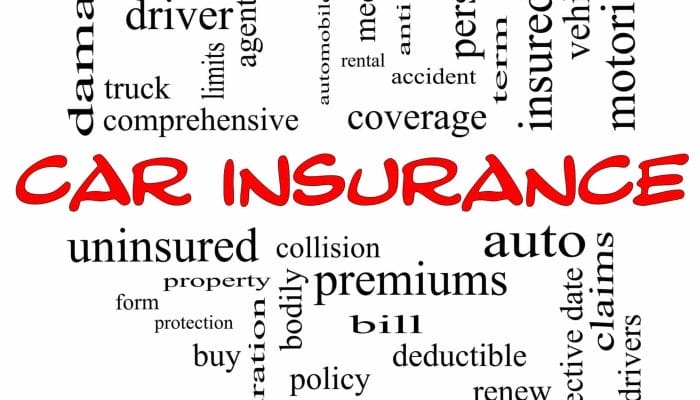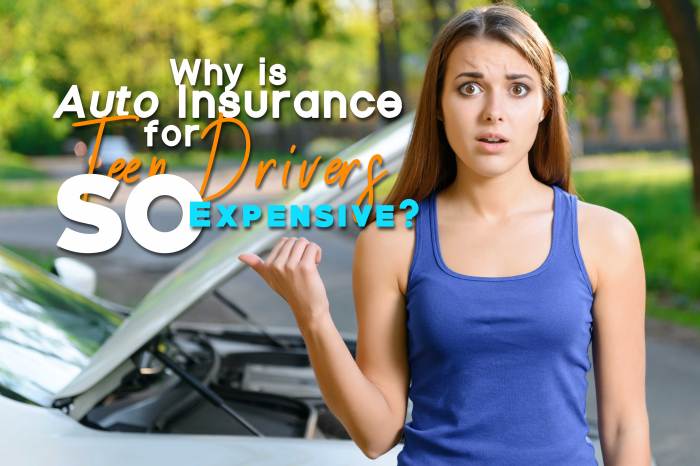Stepping into the world of car ownership as a young driver often comes with the burden of higher insurance premiums. However, with strategic choices and responsible driving habits, it’s possible to navigate the insurance landscape and secure affordable coverage. This comprehensive guide delves into ten effective strategies that young drivers can employ to minimize their insurance costs while maintaining adequate protection.
From exploring safety features and maintaining a clean driving record to taking advantage of discounts and considering usage-based insurance, this guide provides a roadmap to help young drivers make informed decisions and save money on their insurance premiums.
Safety Features

The presence of advanced safety features in a car can potentially lower insurance premiums. These features are designed to prevent accidents, reduce the severity of collisions, and improve the overall safety of the vehicle. By minimizing the likelihood of accidents and the severity of damages, these features can make drivers more attractive to insurance companies, resulting in lower insurance premiums.explanatory
paragraphSome specific safety features that insurance companies typically consider include:
- Airbags: Airbags help protect drivers and passengers in the event of a collision by inflating rapidly to cushion the impact.
- Anti-lock brakes (ABS): ABS helps prevent wheels from locking up during braking, which can lead to loss of control.
- Traction control: Traction control helps prevent wheels from spinning when accelerating, which can help maintain control of the vehicle.
- Electronic stability control (ESC): ESC helps prevent the vehicle from skidding by applying brakes to individual wheels and adjusting the engine power.
- Lane departure warning: Lane departure warning systems alert drivers when they are drifting out of their lane.
- Blind spot monitoring: Blind spot monitoring systems alert drivers to the presence of other vehicles in their blind spot.
- Forward collision warning: Forward collision warning systems alert drivers to the presence of an impending collision and can apply the brakes automatically to avoid or mitigate the impact.
Cost-benefit analysisWhen considering the cost-benefit analysis of opting for a vehicle with advanced safety features, it is important to weigh the potential reduction in insurance premiums against the initial cost of the vehicle. While vehicles with advanced safety features may have a higher initial cost, the long-term savings on insurance premiums can potentially offset this cost.
Additionally, the improved safety of the vehicle can provide peace of mind and reduce the likelihood of accidents, which can have a positive impact on the driver’s overall quality of life.
Driving Record

Maintaining a clean driving record is crucial for young drivers seeking affordable insurance rates. A good driving record demonstrates responsibility and adherence to traffic laws, making you a less risky driver in the eyes of insurance companies. Conversely, a poor driving record, marked by traffic violations, accidents, or DUIs, can lead to significantly higher insurance premiums.
Avoiding Traffic Violations and Accidents
Young drivers can maintain a good driving record by avoiding traffic violations and accidents. This includes obeying speed limits, stopping at stop signs and red lights, and using turn signals properly. Additionally, practicing defensive driving techniques, such as maintaining a safe following distance, avoiding distractions, and being aware of other vehicles and pedestrians, can help prevent accidents.
Consequences of a Poor Driving Record
A poor driving record can have several negative consequences, including:
- Higher Insurance Premiums: Insurance companies view drivers with poor driving records as higher risks, resulting in higher insurance premiums.
- Difficulty Obtaining Insurance: In some cases, drivers with multiple traffic violations or accidents may have difficulty obtaining insurance altogether.
- Loss of Driving Privileges: Accumulating too many traffic violations can lead to the suspension or revocation of a driver’s license.
Vehicle Type
The type of vehicle a young driver chooses can significantly impact their insurance rates. Generally, vehicles that are more expensive to repair or have a history of accidents tend to be more costly to insure. Additionally, insurance companies also consider factors such as the safety features and driving record of the young driver when determining the insurance rates.
Vehicle Characteristics
When choosing a vehicle, young drivers should consider factors such as the safety features, reliability, and repair costs. Vehicles with advanced safety features, such as airbags, anti-lock brakes, and electronic stability control, are generally more affordable to insure. Additionally, vehicles with a history of reliability and low repair costs are also more likely to have lower insurance rates.
Vehicle Types and Rates
Generally, sedans and hatchbacks are typically more affordable to insure for young drivers compared to sports cars or high-performance vehicles. This is because sedans and hatchbacks are generally less expensive to repair and have a lower risk of accidents. On the other hand, sports cars and high-performance vehicles are often more costly to repair and have a higher risk of accidents, resulting in higher insurance rates.
Safety Features and Rates
Insurance companies place a significant emphasis on the safety features of a vehicle when determining insurance rates. Vehicles with advanced safety features, such as airbags, anti-lock brakes, and electronic stability control, are generally more affordable to insure compared to vehicles without these features.
This is because vehicles with advanced safety features are less likely to be involved in accidents, resulting in lower insurance rates.
Insurance Discounts

Young drivers often face higher insurance premiums due to their lack of experience and increased risk of accidents. However, there are several discounts available that can help them save money on their insurance policies.
Good Student Discount
Many insurance companies offer good student discounts to young drivers who maintain a certain grade point average (GPA). This discount can typically range from 5% to 25% off the base premium. To be eligible, students must typically provide proof of their GPA, such as a transcript or report card.
Multi-Car Discount
If a young driver is part of a household with multiple vehicles, they may be eligible for a multi-car discount. This discount is typically offered when two or more vehicles are insured with the same company. The discount can vary depending on the insurance company, but it can often save drivers up to 15% on their premiums.
Defensive Driving Course Discount
Taking a defensive driving course can help young drivers learn how to drive more safely and reduce their risk of accidents. Some insurance companies offer discounts to drivers who complete these courses. The discount can typically range from 5% to 10% off the base premium.
Bundling Discounts
Bundling multiple insurance policies with the same company can often save drivers money. For example, a young driver who bundles their auto insurance with their renters or homeowners insurance may be eligible for a discount. The discount can vary depending on the insurance company, but it can often save drivers up to 20% on their premiums.
Pay-As-You-Drive Discount
Some insurance companies offer pay-as-you-drive (PAYD) programs that allow young drivers to pay for their insurance based on how much they drive. This can be a good option for drivers who do not drive very often or who have low annual mileage.
The discount can vary depending on the insurance company and the driver’s driving habits, but it can often save drivers up to 30% on their premiums.
Usage-Based Insurance
Usage-based insurance (UBI) programs are innovative insurance policies that reward young drivers for safe driving habits. By monitoring driving behavior through devices like telematics or smartphone apps, UBI programs offer personalized insurance rates based on actual driving patterns, potentially saving young drivers money.UBI
programs vary among insurance companies, but they typically track factors such as mileage, speed, braking, and acceleration. The data collected is analyzed to assess an individual’s driving habits and determine their risk level. Drivers who demonstrate safer driving habits, such as maintaining lower speeds, avoiding harsh braking and acceleration, and driving fewer miles, may qualify for lower insurance rates.
UBI Program Types
There are two main types of UBI programs:
- Pay-as-you-drive (PAYD): PAYD programs charge drivers based on the number of miles they drive. The more miles driven, the higher the insurance premium.
- Pay-how-you-drive (PHYD): PHYD programs consider not only the number of miles driven but also the manner in which the vehicle is operated. Factors like speeding, harsh braking, and rapid acceleration can all impact insurance rates.
Tips for Optimizing UBI Savings
Young drivers can take proactive steps to optimize their driving habits and maximize their savings with UBI programs:
- Drive Safely: Practice defensive driving techniques, obey speed limits, and avoid aggressive driving behaviors.
- Minimize Mileage: Reduce unnecessary trips and carpooling or public transportation whenever possible.
- Use Cruise Control: Maintaining a consistent speed can help reduce harsh braking and acceleration.
- Avoid Nighttime Driving: Nighttime driving is often associated with higher risk, which can impact UBI rates.
- Enroll in Driver Safety Courses: Completing approved driver safety courses can demonstrate safe driving habits and may lead to UBI discounts.
Bundling Policies

Bundling auto insurance with other insurance policies, like home or renters insurance, can be a smart financial move for young drivers.
Bundling your policies can save you money on your overall insurance costs. Many insurance companies offer discounts when you bundle your policies with them. For example, State Farm offers a discount of up to 25% when you bundle your auto and home insurance policies.
Geico offers a discount of up to 15% when you bundle your auto and renters insurance policies.
Potential Cost Savings
The amount of money you can save by bundling your policies will vary depending on the insurance company you choose and the policies you bundle. However, you can typically save hundreds of dollars per year by bundling your policies.
Comparative Shopping

Shopping around for the best insurance rates is a crucial step for young drivers seeking affordable coverage. Comparing quotes from multiple insurance companies allows you to find the most competitive rates and coverage options tailored to your specific needs and budget.
Research and Comparison
Begin by gathering quotes from at least three different insurance companies. You can obtain quotes online, through insurance agents, or by calling the insurance companies directly. When comparing quotes, pay attention to the following factors:
- Coverage: Ensure that each quote provides the coverage you require, including liability, collision, comprehensive, and any additional coverage you deem necessary.
- Deductible: The deductible is the amount you pay out of pocket before your insurance coverage kicks in. Higher deductibles typically result in lower premiums, but make sure you choose a deductible that you can afford to pay if needed.
- Premium: The premium is the amount you pay for your insurance coverage. Compare the premiums from different companies to find the most affordable option.
- Customer Service: Consider the reputation and customer service ratings of each insurance company. Read online reviews and ask for recommendations from friends or family members who have experience with different insurance providers.
Raising Deductible

In the realm of auto insurance, the deductible refers to the predetermined amount a policyholder agrees to pay out of pocket before their insurance coverage kicks in. Increasing the deductible can be a strategic move to lower insurance premiums. By assuming more financial responsibility for minor accidents and repairs, drivers can reduce the perceived risk for insurance companies, resulting in lower insurance rates.
Impact of Deductible on Insurance Rates
The correlation between deductible amount and insurance rates can be observed through the following table:
| Deductible Amount | Impact on Insurance Rates |
|---|---|
| $500 | Higher premiums |
| $1,000 | Moderate premiums |
| $2,000 | Lower premiums |
As the deductible amount increases, the insurance premiums generally decrease. This is because the insurance company assumes less risk, leading to lower rates.
Pros and Cons of a Higher Deductible
Opting for a higher deductible offers several advantages. Primarily, it results in lower insurance premiums. Additionally, it encourages responsible driving behavior, as drivers are more cautious knowing they will bear the initial costs of any accidents.
However, there are also potential drawbacks to consider. In the event of an accident, the policyholder will have to pay a larger amount out of pocket before their insurance coverage applies. This can be financially challenging, especially for those with limited savings or those involved in costly accidents.
Maintaining Good Credit

Maintaining a good credit score can have a positive impact on insurance rates for young drivers. Insurance companies often consider a good credit score as an indicator of responsibility and financial stability. This can lead to lower insurance rates, as insurers view drivers with good credit as less risky.
Building and maintaining a good credit score
- Pay bills on time: Paying bills on time, including credit card bills, rent, and other monthly payments, is crucial for building a good credit score.
- Keep credit utilization low: Credit utilization is the amount of credit you’re using compared to your total credit limit. Keeping your credit utilization low shows lenders that you’re not overextending yourself and can manage your debt.
- Don’t open too many credit accounts in a short period: Opening multiple credit accounts in a short period can negatively affect your credit score. Instead, space out your applications for new credit.
- Monitor your credit report regularly: Regularly checking your credit report allows you to identify and correct any errors that could negatively impact your score.
Impact of poor credit on insurance rates
- Higher insurance premiums: Young drivers with poor credit scores may face higher insurance premiums compared to those with good credit.
- Limited insurance options: Drivers with poor credit may have fewer insurance options available to them, as some insurers may be reluctant to offer coverage to high-risk drivers.
- Difficulty obtaining a loan: A poor credit score can also make it difficult to obtain a loan for a car or other purposes, as lenders may view you as a higher-risk borrower.
Defensive Driving Courses

Taking defensive driving courses offers numerous advantages to young drivers, including improved driving skills, increased road safety awareness, and potential cost savings on auto insurance premiums.Completing defensive driving courses can help young drivers learn essential skills to navigate challenging driving situations safely, such as skid control, hazard recognition, and evasive maneuvers.
These courses also emphasize the importance of obeying traffic laws, maintaining a safe following distance, and avoiding distractions while driving.
Types of Defensive Driving Courses
There are various types of defensive driving courses available, both online and in-person. Online courses provide flexibility and convenience, allowing young drivers to learn at their own pace. In-person courses offer the benefit of hands-on instruction and the opportunity to practice driving techniques in a controlled environment.To
find defensive driving courses, young drivers can check with their local DMV, driving schools, or insurance companies. Many insurance companies offer discounts on auto insurance premiums for drivers who complete approved defensive driving courses.
Potential Cost Savings
Completing defensive driving courses can lead to significant cost savings on auto insurance premiums for young drivers. Insurance companies view drivers who have completed these courses as lower-risk drivers, making them eligible for lower insurance rates. The amount of savings can vary depending on the insurance company and the specific course taken, but it can be substantial, especially for young drivers who are typically charged higher premiums.
Last Point
In conclusion, securing affordable insurance as a young driver requires a combination of smart choices and responsible driving habits. By prioritizing safety, maintaining a clean record, opting for suitable vehicles, and taking advantage of available discounts, young drivers can navigate the insurance maze and obtain coverage that fits their budget without compromising protection.
Remember, the journey to affordable insurance begins with informed decisions and a commitment to safe driving.
Frequently Asked Questions
Q: Can I get a discount on my insurance if I have a good GPA?
A: Yes, many insurance companies offer good student discounts to young drivers who maintain a certain grade point average. Check with your insurance provider to see if you qualify.
Q: What is usage-based insurance (UBI), and how can it save me money?
A: Usage-based insurance programs track your driving habits, such as mileage, time of day, and braking patterns, to determine your insurance premium. By practicing safe driving habits, you can potentially lower your insurance costs with UBI.
Q: What are the benefits of bundling my auto insurance with other policies?
A: Bundling your auto insurance with other policies, such as home or renters insurance, can often lead to significant savings. Many insurance companies offer bundling discounts, so be sure to inquire about this option.
Q: How can I improve my credit score to lower my insurance rates?
A: Maintaining a good credit score can positively impact your insurance rates. Pay your bills on time, keep your credit utilization low, and avoid taking on excessive debt to improve your credit score.



